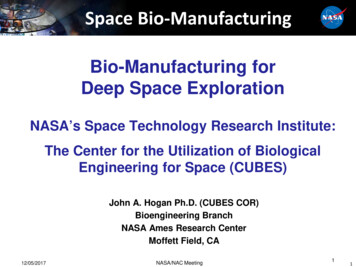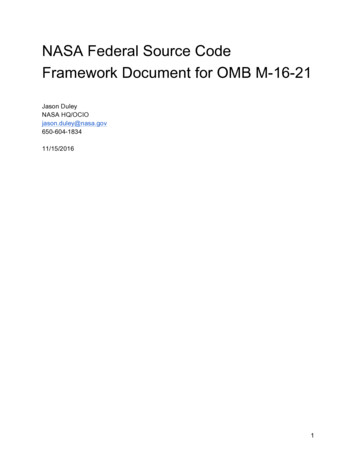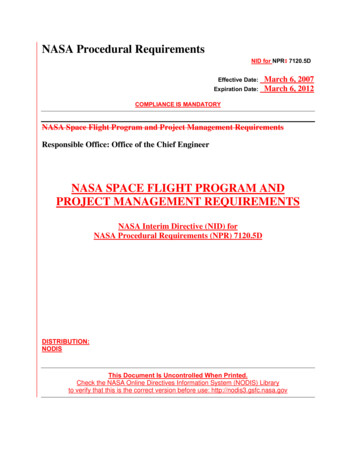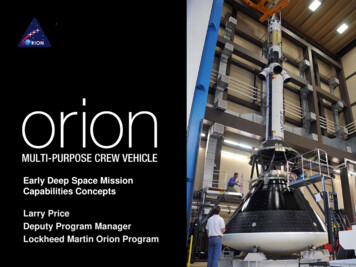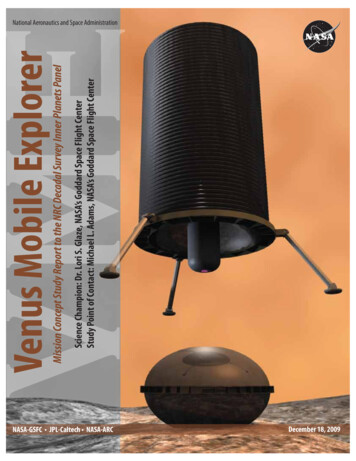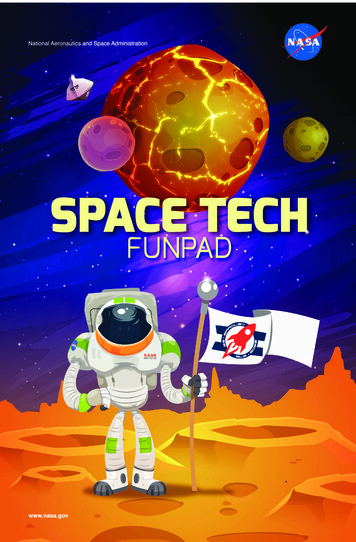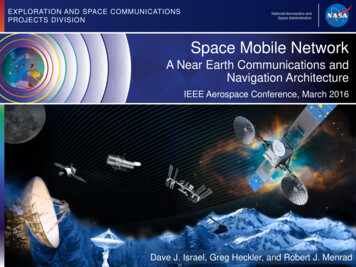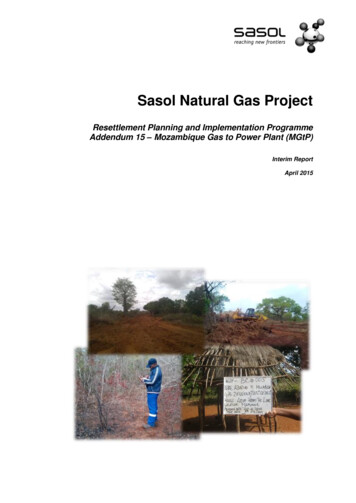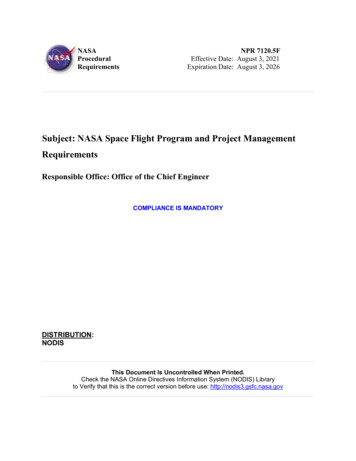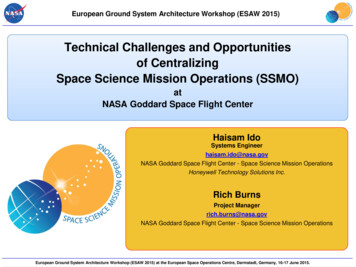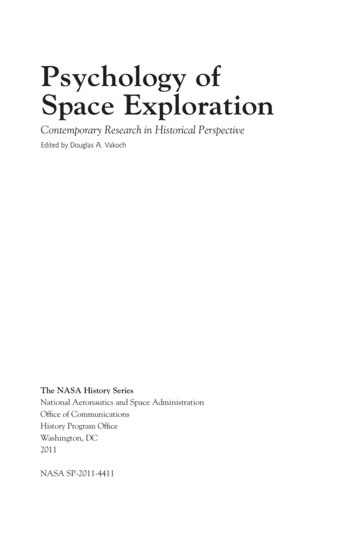
Transcription
Psychology ofSpace ExplorationContemporary Research in Historical PerspectiveEdited by Douglas A. VakochThe NASA History SeriesNational Aeronautics and Space AdministrationOffice of CommunicationsHistory Program OfficeWashington, DC2011NASA SP-2011-4411
0Library of Congress Cataloging-in-Publication DataPsychology of space exploration : contemporary research in historical perspective /edited by Douglas A. Vakoch.p. cm. -- (NASA history series)1. Space psychology. 2. Space flight--Psychological aspects. 3. Outer space--Exploration. 4. Space sciences--United States. I. Vakoch, Douglas A. II. United States.National Aeronautics and Space Administration.RC1160.P79 2009155.9’66--dc222009026665For sale by the Superintendent of Documents, U.S. Government Printing OfficeInternet: bookstore.gpo.gov Phone: toll free (866) 512-1800; DC area (202) 512-1800Fax: (202) 512-2104 Mail: Stop IDCC, Washington, DC 20402-0001I S B N 978-0-16-088358-3
To Julie and Len
THIS PAGE INTENTIONALLY BLANK
Table of ContentsForewordAcknowledgmentsChapter 1. Introduction: Psychology and the U.S. Space Programviiix1Albert A. Harrison, Department of Psychology, University of California, DavisEdna R. Fiedler, National Space Biomedical Research Institute, Baylor Collegeof MedicineSection I: Surviving and Thriving in Extreme EnvironmentsChapter 2. Behavioral Health17Albert A. Harrison, Department of Psychology, University of California, DavisEdna R. Fiedler, National Space Biomedical Research Institute, Baylor Collegeof MedicineChapter 3. From Earth Analogs to Space: Getting There from Here47Sheryl L. Bishop, Department of Preventive Medicine and Community Healthand School of Nursing, University of Texas Medical BranchChapter 4. Patterns in Crew-Initiated Photography of Earth from theISS—Is Earth Observation a Salutogenic Experience?79Julie A. Robinson, Office of the ISS Program Scientist, National Aeronauticsand Space Administration (NASA) Johnson Space Center (JSC)Kelley J. Slack, Behavioral Health and Performance Research, Wyle LaboratoriesValerie A. Olson, Department of Anthropology, Rice UniversityMichael H. Trenchard, Image Science and Analysis Laboratory, Engineering andScience Contract Group (ESCG), NASA JSCKimberly J. Willis, Image Science and Analysis Laboratory, ESCG, NASA JSCPamela J. Baskin, Behavioral Health and Performance Research, Wyle LaboratoriesJennifer E. Boyd, Department of Psychiatry, University of California, SanFrancisco; and San Francisco Veterans Affairs Medical Centerv
Psychology of Space ExplorationSection II: Managing Interpersonal Conflict in SpaceChapter 5. Managing Negative Interactions in Space Crews: The Role ofSimulator Research103Harvey Wichman, Aerospace Psychology Laboratory, Claremont McKennaCollege and Claremont Graduate UniversityChapter 6. Gender Composition and Crew Cohesion During Long-DurationSpace Missions125Jason P. Kring, Department of Human Factors and Systems, Embry-RiddleAeronautical UniversityMegan A. Kaminski, Program in Human Factors and Applied Cognition, GeorgeMason UniversitySection III: Multicultural Dimensions of Space ExplorationChapter 7. Flying with Strangers: Postmission Reflections ofMultinational Space Crews143Peter Suedfeld, Department of Psychology, University of British ColumbiaKasia E. Wilk, Youth Forensic Psychiatric Services Research and EvaluationDepartment, Ministry of Children and Family DevelopmentLindi Cassel, Department of Occupational Therapy, Providence Health CareChapter 8. Spaceflight and Cross-Cultural Psychology177Juris G. Draguns, Department of Psychology, Pennsylvania State UniversityAlbert A. Harrison, Department of Psychology, University of California, DavisAfterword. From the Past to the Future195Gro Mjeldheim Sandal, Department of Psychosocial Science, University of BergenGloria R. Leon, Department of Psychology, University of MinnesotaAbout the AuthorsAcronyms and AbbreviationsThe NASA History SeriesSubject IndexAuthors Citedvi205219221235249
ForewordEach month, the cover of Monitor on Psychology, a magazine sent to over onehundred thousand members of the American Psychological Association, reflectsintriguing new areas of interest to psychologists who work as researchers, clinicians,consultants, and teachers. The importance of human adaptation to space for contemporary psychologists is suggested by the cover of the March 2008 Monitor, whichfeatured an astronaut drifting in space, with the tranquil blue Earth in the background and the caption “Deep Space Psych” below.At one level, the essays in this volume provide an overview and synthesis ofsome of the key issues in the psychology of space exploration, as well as a samplingof highly innovative empirical research. The characteristic that most clearly setsthis collection apart from others, however, is the depth with which the authorshave engaged the history of the psychology of space exploration.All psychologists are familiar with the importance of engaging past research andtheory while conducting literature reviews in preparation for designing and interpreting new studies. But the contributors to this collection have done much more.They have crafted essays that will be of obvious value to psychologists, psychiatrists,and other behavioral researchers. At the same time, these authors have created acollection with the promise to promote a greater dialogue between psychologicalresearchers and both historians of space exploration and historians of psychology.Psychologists and historians have quite different criteria for good scholarshipand for communicating their findings. These differences make the essays in this volume—meaningful and accessible even to those not formally trained in psychologists’ methodologies and mindsets—all the more impressive. With the increasingspecialization and isolation of academic disciplines from one another over the pastcentury, these essays serve as a prototype for a broader attempt to bridge the gapbetween the two cultures of science and the humanities that C. P. Snow identifiedalmost a half century ago—quite fittingly for us, near the beginning of the SpaceAge. Let us hope that as we prepare once again to send astronauts beyond Earth’sorbit, we can do so with the guidance of others equally open to seeing beyond theirown specialties.vii
THIS PAGE INTENTIONALLY BLANK
AcknowledgmentsWithout the intellectual leadership of Albert Harrison, this book would neverhave come into existence, and it could not have been completed in such a timelymanner. His contributions will be evident in the three chapters he has coauthored;invisible is his extensive work recruiting other contributors, reviewing chapters,and providing last-minute assistance more times than I care to remember. Muchmore important to me, however, is Al’s ongoing friendship.Over the past decade, many colleagues from the SETI Institute have sharedwith me their insights about the societal and educational impact of space exploration—especially John Billingham, Edna DeVore, Frank Drake, Andrew Fraknoi,John Gertz, Chris Neller, Tom Pierson, Karen Randall, Seth Shostak, and Jill Tarter.More recently, I warmly acknowledge the administration, faculty, staff, and studentsof the California Institute of Integral Studies (CIIS), especially for support fromKatie McGovern, Joseph Subbiondo, and Judie Wexler. The work of editing this volume was made possible through a generous sabbatical leave from my other academicresponsibilities at CIIS. In addition, I thank Harry and Joyce Letaw, as well as JamieBaswell, for their intellectual and financial contributions to promoting the societalaspects of space exploration.Among the organizations that have fostered discussions on the topics in thisvolume, I especially want to recognize the International Academy of Astronautics(IAA) and the American Psychological Association (APA). Several of the chapters in this volume are elaborations of papers first presented at the APA’s 115thAnnual Convention, held in San Francisco in August 2007.For his openness to considering a new topic for the NASA History Series, Ithank Steve Dick; I am also grateful to him and to Steve Garber for leading such athorough and helpful review process and for moving this volume into productionso efficiently.In the Communications Support Services Center at NASA Headquarters,Lisa Jirousek copyedited the manuscript, Christopher Yates designed the layout, Stacie Dapoz and George Gonzalez proofread the layout, and Hanta Ralayand Tun Hla handled the printing. Supervisors Gail Carter-Kane, Cindy Miller,Michael Crnkovic, and Tom Powers oversaw the overall process. Thanks are dueto all of these fine professionals.ix
Psychology of Space ExplorationFinally, I thank the contributors and reviewers of the essays that appear in thisvolume. By taking seriously the importance of history for contemporary psychological research, they have opened new possibilities for interdisciplinary collaborations in the future.Douglas A. VakochMountain View and San Francisco, Californiax
Chapter 1Introduction: Psychology and the U.S. Space ProgramAlbert A. HarrisonDepartment of PsychologyUniversity of California, DavisEdna R. FiedlerNational Space Biomedical Research InstituteBaylor College of MedicineABSTRACTAstronauts live and work in highly unusual and challenging environments wherethey must withstand multiple stressors. Their abilities to maintain positive psychological outlooks and good interpersonal relations are crucial for personal well-being andmission success. From the inception of the space program, psychologists, psychiatrists,human factors experts, and other professionals have warned that the psychologicalstressors of space should be treated as a risk factor and that the risk would increase asmissions involved larger, more diversified crews undertaking increasingly long flights.Thus, they called for research leading to the development and application of effectivecountermeasures. Although psychology played a significant role at the inception of thespace program, for many years thereafter certain areas of psychology all but disappearedfrom NASA. Interest in psychosocial adaptation was rekindled in the mid-1990s whenastronauts joined cosmonauts on the Russian space station Mir. NASA’s recognitionof the field of behavioral health and its links to performance opened the door to manykinds of research that were formerly overlooked. Focusing on the underutilized areas ofpersonality and social psychology, the chapters that follow discuss psychology’s strugglefor acceptance, the history of astronaut selection and psychological support, the use ofanalog environments and simulators for research and training, space tourism, the psychological rewards of viewing Earth from space, crew composition and group dynamics, and cross-cultural aspects of international missions. This book concludes with asummary, integration, and evaluation of the role of psychology in space exploration.1
Psychology of Space ExplorationINTRODUCTION“Once, I was evaluating astronaut applicants” says psychiatristNick Kanas. “I asked them to give me some examples of thingsthat might cause stress.” One applicant, a test pilot, recalled thetime he was flying an experimental aircraft and it spun out of control. As the plane spiraled down, he took out his manual, calmlythumbed through it, and figured out how to pull the plane tosafety. “His ability to temporarily control his emotions was striking,” laughs Kanas.1Fully aware of astronauts’ remarkable strengths, Kanas also knows that manyphysical and psychological stressors can pose risks to safety, performance, and quality of life.2 Some of these stressors are associated with flight: riding atop a rocket;rapid acceleration and deceleration; somewhat primitive living conditions; isolation from family and friends; close confinement with other people; and theever-present specter of a collision, system failure, or other disaster. Other types ofstressors come from the astronaut’s career. From the earliest days of the space program, astronauts have served as societal exemplars, living under intense publicscrutiny; carried heavy workloads on Earth as in space; and undergone prolongedabsences from home for training, flight, and other purposes. They must withstandthe typical hassles of trying to succeed within large bureaucracies, worry over flightassignments, and readjust to their families when they return to Earth.3 J. Kass,R. Kass, and I. Samaltedinov describe how some of this may seem to an astronaut:1. “How Astronauts Get Along,” Science@NASA, 21 October 2002, available at http://science.msfc.nasa.gov/headlines/y2002/21oct getalong.htm (accessed 29 March 2008).2. N. Kanas, “Psychosocial Factors Affecting Simulated and Actual Space Missions,”Aviation, Space, and Environmental Medicine 56, no. 8 (August 1985): 806–811; N. Kanas,“Psychosocial Support for Cosmonauts,” Aviation, Space, and Environmental Medicine 62, no. 4(August 1991): 353–355; N. Kanas, V. P. Salnitskiy, J. B. Ritsher, V. I. Gushin, D. S. Weiss, S.A. Saylor, O. P. Kozerenko, and C. R. Marmar, “Human Interactions in Space: ISS vs. Shuttle/Mir,” Acta Astronautica 59 (2006): 413–419.3. W. E. Sipes and S. T. Vander Ark, “Operational Behavioral Health and PerformanceResources for International Space Station Crews and Families,” Aviation, Space, andEnvironmental Medicine 76, no. 6, sec. II (June 2005): B36–B41.2
Introduction: Psychology and the U.S. Space ProgramHe knows he has been trained and put into space at great costand effort, and he has a limited amount of time, especially during a short shuttle mission, to perform the tasks set out for him,efficiently. The precious data of the scientists on the ground, whohave dedicated many years for this experiment, can be lost, theequipment can be damaged in such a way that it cannot be repairedin space, or worse still, his blunder can affect the safety of life onthe spaceship. Even if such drastic errors are seldom, he is nevertheless under great stress—he has to get the work done quickly,so that the next scheduled event can take place as planned. Thiskind of stress affects him not only as an individual, but as a member of a team: His peers are watching him, and he knows full well,not only will any mistakes made affect their work as well, but hefails in their eyes in a similar manner as a member of a sports team,whose error can affect the success of the team as a whole.4This book discusses selected topics in the psychology of space exploration. In thisand the following chapters, we and other contributors address the changing role ofpsychology within the U.S. space program, review the history of astronaut selectionand training, and describe the evolution of techniques for providing astronauts andcosmonauts with psychological support. Contributing authors explain why and howpsychologists use space-reminiscent settings (such as undersea habitats and polar outposts) for research and training purposes. They trace the not-always-smooth courseof the diversification of the astronaut corps from a homogenous collection of white,male test pilots to a more heterogeneous group including women and minorities.They tell about group dynamics and teamwork, as well as occasional friction betweencrews in flight and people in Mission Control. One of the most dramatic changes over50 years of crewed flight has been the transition from fiercely competitive nationalspace programs to collaborative efforts with international crews, so cultural issues arediscussed. Over the past 50 years, space missions have changed, and so have salientbehavioral issues and opportunities for psychologists.4. J. Kass, R. Kass, and I. Samaltedinov, “Psychological Problems of Man in Space: Problemsand Solutions,” Acta Astronautica 36 (1995): 657–660.3
Psychology of Space ExplorationHow has psychology fared in the U.S. space program? In his presidential addressto the Division of Engineering Psychology on 4 September 1961, Walter F. Gretheraffirmed psychology’s crucial role in the newly initiated conquest of space, notingthat psychologists of that day were responding with creativity and vigor to the enormous behavioral challenges.5 Looking back over the history of aviation, Gretherremarked that despite a few contributions to military aviation in World War I, forroughly 35 years after the Wright brothers’ initial flight at Kitty Hawk, aviationand psychology pretty much went separate ways. Then, beginning with researchto benefit civilian aviation in the late 1930s and followed by a powerful militaryprogram in World War II, aviation psychology became prominent and influential.“How much different the role of psychology has been in man’s early ventures intospace!” Grether wrote.6 Psychological testing, he continued, was prominent in theselection of the initial seven Mercury astronauts, and beyond selection psychologists were productively engaged in vehicle design, training, task design, and workload management.Grether pointed to four areas for future research: moving about the interior ofspacecraft (once they became large enough for this to occur), conducting extravehicular activities (EVAs) or “spacewalks,” performing rendezvous, and living andworking under conditions of prolonged isolation and confinement. Highly optimistic about America’s future in space, Grether foresaw a strong continuing partnershipbetween psychology and space exploration. One of his few notes of pessimism—that it would not be possible to use the science fiction writer’s rocket gun to movefrom place to place during EVAs—would soon be proven wrong. Beyond providing psychologists with new opportunities for employment and research support, hefelt, space exploration would open new frontiers of knowledge and stimulate thinking about new problems that would lead to new theories, hypotheses, and methods.Nearly three decades later, participants at the 30th anniversary of the 1959founding of the International Ergonomics Association might conclude that Gretherwas right. In the field generally known as human factors in the U.S. and ergonomicsin the United Kingdom (U.K.) and Europe, human factors specialists are interestedin the scientific problems of experimental psychology, anatomy, and physiology5. W. F. Grether, “Psychology and the Space Frontier,” American Psychologist 17, no. 2(February 1962): 92–101.6.4Ibid., pp. 92–93.
Introduction: Psychology and the U.S. Space Programapplied to human work. Classically, human factors addresses people’s interactionwith physical environments in work settings, but the interests of human factors specialists have broadened over the years.7In this 1989 presidential address to the association, Alphonse Chapanis couldpoint with pride to rapidly accumulating accomplishments everywhere in the field.8Floods of data were appearing in area after area of human activity (work, transportation, leisure-time pursuits), and it was no longer possible to keep abreast ofthe latest journals and books. The hottest topic of 1989 was computers: how theyhad revolutionized society, how they spread beyond science and business and wereembraced by everyday people, and how they could be humanized through thedesign of displays and controls. Certainly, much was left to be done—over the lifetime of the association, 71 major railroad disasters had claimed 5,059 persons; 192major aircraft accidents had killed over 20,000 people; and, in the previous 10 yearsalone, there had been thousands of nuclear “mishaps,” including prominent eventsat Chernobyl and Three Mile Island. Still, Chapanis’s theme was that ergonomicshad “come a long way, baby,” and that the biggest stimulus for this was America’sforays into space:Space flights have become so commonplace and so much is knownabout human performance in space that it is hard to remember thethousands of analyses, studies, and experiments that were doneto pave the way for man’s leap into these hostile and unknownregions. There were problems of vehicle design involving exoticdisplays and controls. There were problems of vibration, ofg-forces, and of weightlessness that had to be explored and solved.For extravehicular activity an entire self-contained environmenthad to be designed for astronauts and cosmonauts. Torquelesstools had to be designed for use by men who were floating freelyand encumbered by space suits with limited mobility. There wereproblems of nutrition, waste disposal, and work-rest cycles. Nor7. D. Meister, Conceptual Aspects of Human Factors (Baltimore, MD: Johns HopkinsUniversity Press, 1989).8. A. Chapanis, “The International Ergonomics Association: Its First 30 Years,” Ergonomics33, no. 3 (1990): 275–282.5
Psychology of Space Explorationcan we forget the problems of selection, training, and simulatordesign . . . . Our leap into space was a significant accomplishmentof the past 30 years and the ergonomic findings that helped bringit about have enriched our profession in countless ways.9But other assessments of psychologists’ contributions to the U.S. space programwere less triumphant. In 1975, Robert L. Helmreich expressed pessimistic views ofapplying psychology in new areas, stating that prospective customers often respondwith profound indifference.10 In 1983, he elaborated on how data relating to personality and social psychology were underused by the U.S. space program, which (as weshall see in chapter 2) he considered in contrast to robust use in the Soviet program.11In a 1987 conference cosponsored by NASA and the National Science Foundation,psychologist and management consultant Philip R. Harris observed that[a]lthough NASA has been forthright about medical and biological insights gained from previous spaceflights . . . the agency hasbeen hesitant on studying or releasing information on the psychosocial experience of its personnel in space. Generally, NASA haslimited the access to astronauts by social science researchers, evenby its own psychiatrists and psychologists; the agency has failed tocapitalize on the data it collected that could improve spaceflightand living for others to follow.12In the early 1990s, outgoing flight surgeon and psychiatrist Patricia Santy concluded that despite an initial flurry of interest, behavioral research all but disap-9.Ibid., pp. 276–277.10. R. L. Helmreich, “Applied Social Psychology: The Unfulfilled Promise,” Personality andSocial Psychology Bulletin 1 (1975): 548–561.11. R. L. Helmreich, “Applying Psychology to Outer Space: Unfulfilled Promises Revisited,”American Psychologist 38 (1983): 445–450.12. P. R. Harris, “Personnel Deployment Systems: Managing People in Polar and Outer SpaceEnvironments,” in From Antarctica to Outer Space: Life in Isolation and Confinement, ed. A. A.Harrison, Y. A. Clearwater, and C. P. McKay (New York: Springer, 1990), pp. 77–78.6
Introduction: Psychology and the U.S. Space Programpeared from NASA.13 For years, she wrote, psychology played a minimal role inastronaut selection, and because the assessment of individual astronaut performancewas prohibited, it was not possible to collect normative data for test validation andother purposes. She characterized the application of psychology to space as running 20 to 30 years behind most areas of medicine and identified formidable organizational barriers to psychology within NASA. Joseph V. Brady, whose research onprimate behavior in spaceflight dates back to the 1950s, states that following JohnGlenn’s flight, there was a dearth of in-flight behavioral experiments.14 Brady characterizes this as a 30-year hiatus in psychological health research for NASA, a gapthat he thought must come to an end given NASA’s vision for humans in space.Peter Suedfeld cuts to the heart of the matter: “Through most of NASA’s existence,the behavioral sciences have been barely visible on the agency’s horizon.”15How can we reconcile such pessimistic views with the optimistic assessmentsof Grether and Chapanis? Robert Helmreich’s point was that, generally, those disciplines that are rooted in biology, engineering, and experimental psychology havefound greater acceptance within the space program than disciplines rooted in personality, social, and organizational psychology. Lawrence Palinkas, an anthropologist who has developed an enviable record of hands-on research experience inunusual environments, organized these issues in long-term spaceflight into three“domains”: the individual domain (stress and coping), the group dynamics domain(social interaction and intergroup relations), and the organizational domain (management, organizational culture, and behavior).16From the beginning, physicians, psychologists, and their allies advocated strongbehavioral research programs in NASA. Margaret A. Weitekamp points out howinterest in high-altitude flight in the 1930s initiated research that evolved into aero-13. P. A. Santy, Choosing the Right Stuff: The Psychological Selection of Astronauts andCosmonauts (Westport, CT: Praeger, 1994).14. J. V. Brady, “Behavioral Health: The Propaedeutic Requirement,” Aviation, Space, andEnvironmental Medicine 76, no. 6, sect. II (June 2005): B13–B23.15. P. Suedfeld, “Invulnerability, Coping, Salutogenesis, Integration: Four Phases ofSpaceflight Psychology,” Aviation, Space, and Environmental Medicine 76, no. 6, sect. II (June2005): B61.16. L. Palinkas, “Psychosocial Issues in Long-Term Space Flight: An Overview,” Gravitationaland Space Biology Bulletin 12, no. 2 (2001): 25–33.7
Psychology of Space Explorationspace medicine in the 1940s.17 Research to support pilots flying very fast and very highprovided a basis for sending astronauts into space. The first conference with “space” inthe title was prior to 1950, notes Weitekamp, but some space-oriented research wasclandestine or integrated into aviation medicine and psychology in order to avoidthe wrath of superiors who thought it wasteful to study “Buck Rogers” issues. In 1961,Bernard Flaherty edited Psychophysiological Aspects of Space Flight, which focused onthe sensory and biotechnical aspects of spaceflight and simulations, as well as addressing issues of human durability.18 Human Factors in Jet and Space Travel also appearedthat year.19 The latter was edited by Saul B. Sells, a NASA consultant who first wroteabout astronaut selection and training in 1957, and Charles A. Berry, at one timeNASA Director of Life Science and physician to the astronauts. They dealt with performance under conditions of acceleration and deceleration, as well as human adaptation to space. In 1967, Joseph Kubis, along with Edward J. McLaughlin, specificallyaddressed the psychological aspects of spaceflight.20 They noted that whereas shortterm spaceflight did not have adverse effects on functioning, factors such as emotionalstability and group dynamics could prove important in future missions. As wouldmany other writers, they illustrated their points with studies of psychological reactions to isolation and confinement in terrestrial settings.In the early 1970s, Joseph Kubis addressed issues of group dynamics: groupcomposition, leadership, and teamwork.21 In 1971, Air Force psychiatrist NickKanas, in collaboration with William E. Fedderson, released an outline of manyof the psychological and psychiatric issues that have filtered down and influencediscussions today.2217. M. A. Weitekamp, Right Stuff Wrong Sex: America’s First Women in Space Program(Baltimore, MD: Johns Hopkins University Press, 2004).18. B. E. Flaherty, Psychophysiological Aspects of Space Flight (New York: Columbia UniversityPress, 1961).19. S. B. Sells and C. A. Berry, eds., Human Factors in Space and Jet Travel: A MedicalPsychological Analysis (New York: Ronald Press, 1961).20. J. F. Kubis and E. J. McLaughlin, “Psychological Aspects of Spaceflight,” Transactions of theNew York Academy of Sciences 30, no. 2 (1967): 320–330.21. J. F. Kubis, “Isolation, Confinement, and Group Dynamics in Long Duration Spaceflight,”Acta Astronautica 17 (1972): 45–72.22. N. Kanas and W. E. Fedderson, Behavioral, Psychiatric, and Sociological Problems of LongDuration Missions (Washington, DC: NASA Technical Memorandum X-58067, 1971).8
Introduction: Psychology and the U.S. Space ProgramIn 1972, the National Academy of Sciences released the report of a studypanel chaired by Donald B. Lindsley of the University of California, Los Angeles(UCLA).23 The panel sought “to indicate the blocks of research, roughly in orderof priority that will be most fruitful in the years ahead in coming to grips with theproblems of long-duration missions . . . . In this, there is little doubt in the mindsof the study participants that the difficulties are formidable, the unknowns significant, and the prerequisite research extensive . . . .”24 Many of the experts wereinterested in space physiology and medicine, but the panel also included psychologists with expertise in stress, social interaction, and behavior in unusual environments. In addition to recommending basic biomedical and life-support research, thepanel urged studies of skilled performance, environmental habitability, group processes, interpersonal interaction, and the relationship of the space crew “microsociety” to the larger flight team. In 1977, partially in response to Lindsley’s report,Mary M. Connors and her associates began a review of the then-current foundations for understanding behavior during anticipated Space Shuttle and space station missions.25 Their report, not published until 1985, identified a middle groundbetween narrowly focused experiments and bold generalizations. They adopted anopen systems approach and addressed topics at the individual, small group, andorganizational levels.In the late 1980s, the Committee on Space Biology and Medicine of theNational Research Council gave further impetus to psychology, noting that“[a]lthough the evidence is fragmentary, it seems likely that behavioral and socialproblems have already occurred during long-term missions . . . . A
Psychology of space exploration : contemporary research in historical perspective / edited by Douglas A. Vakoch. p. cm. -- (NASA history series) 1. Space psychology. 2. Space flight--Psychological aspects. 3. Outer space--Explo - ration. 4. Space sciences--United States. I. Vakoch, Douglas A. II. United States. National Aeronautics and Space Administration. RC1160.P79 2009 155.9'66--dc22 .
